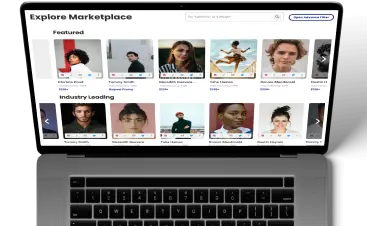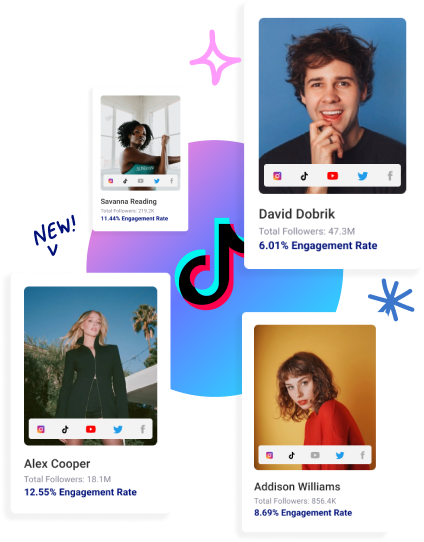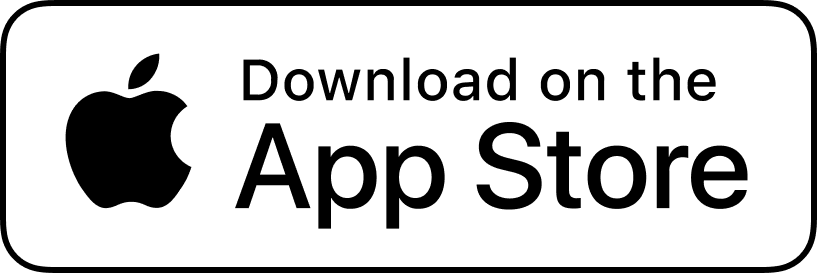As a marketing manager, you are surely aware that one of the most important aspects of your job is to produce creative and effective marketing campaigns to help your company achieve its goals. You also already know that traditional marketing methods are no longer enough in today’s rapidly changing digital age. That’s why you need to be incorporating an influencer marketing strategy into your marketing goals.
But what exactly is influencer marketing for brands? And how can you create an influencer marketing strategy that works? Keep reading to find out.
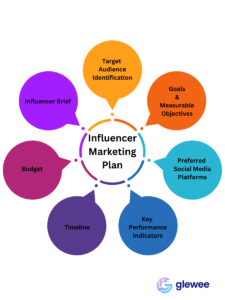
What Is an Influencer Marketing Strategy?
An influencer marketing strategy is essentially a strategy for working directly with influencers—people with large online followings who can help promote your product or service.
Influencer marketing strategies can vary depending on the company’s goals and budget. A solid influencer marketing plan should include the following:
- The brand’s target audience (the audience that brands want to reach)
- Campaign goals and measurable objectives (what needs to happen)
- The campaign’s preferred social media platforms (Instagram, TikTok, Twitter, Ect.)
- The campaign’s key performance indicators, or KPIs (how a brand will measure its success)
- A timeline
- A budget
Brand managers, however, often start by writing an influencer marketing strategy to outline the types of influencers the brand wants to work with and often forget the plan’s other key components.
When influencer marketing is done right, it can be a highly effective way to reach new customers and grow your business.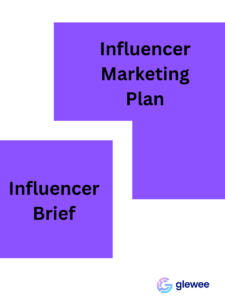
What Is the Difference Between a Brand’s Influencer Marketing Strategy and an Influencer’s Brief?
The brand’s influencer marketing strategy is the overall plan that outlines the campaign from start to finish with an array of different influencers across various social media platforms. This plan is primarily used by the brand rather than the influencer.
The influencer brief is a document created by the brand or agency that outlines the campaign’s details. Typically, influencer briefs include information about the brand and product being promoted, the desired marketing channels, branded hashtags, a style and formatting guide, the campaign’s goal and how the brand will measure its success. Additionally, the influencer brief lays out the brand’s expectations and lays the groundwork for the execution of a seamless campaign.
Think of the brand’s influencer marketing plan as a macro-overview of the campaign while the influencer’s brief is the micro and hyper-specific plan with tactical details.
Why Brands Need an Influencer Marketing Strategy and an Influencer Brief?
If you’re running a business, chances are you’re always looking for new ways to reach your target audience. With the rise of social media, influencer marketing has become one of the most effective ways to accomplish this.
Successful campaigns have both an influencer marketing strategy and an influencer brief to keep everyone on track. The influencer marketing plan is for the brand while the influencer brief is for the influencer or creator.
Brands start by creating an influencer marketing strategy to properly execute and measure their campaigns. Within the plan is an influencer brief intended for the influencer, which further describes the step-by-step process that influencers, creators and brand partners will follow throughout the campaign.
A well-crafted influencer brief can help to avoid potential misunderstandings and miscommunications between businesses and influencers. Ultimately, an influencer brief helps to create a more efficient and effective campaign, which almost always produces a much better return on investment (ROI).
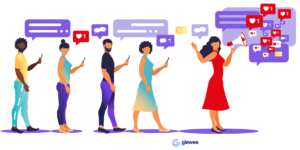
What Is Influencer Marketing?
Influencer marketing is a type of social media marketing that involves companies and their brands that work with individuals who have a significant following on social media. As a result, these individuals work closely with companies to promote a brand or product, aligning themselves with the brand throughout the campaign. These individuals, known as “influencers,” can help to increase brand awareness, drive traffic and improve your sales.
Why Is Influencer Marketing Important?
There are a few reasons why influencer marketing is so important. First, social media is one of the most effective ways to reach a brand’s target audience. According to numerous studies, more than half of all internet users say they have purchased a product after seeing a mention or endorsement on social media.
Take a look at a few of these influencer marketing statistics from the Digital Marketing Institute:
- 70% of Teens Trust Influencers More than Traditional Celebrities
- 49% of Consumers Depend on Influencer Recommendations
- 82% of People Trust Social Networks to Guide Purchasing Decisions
- 41% of Twitter Users Intended to Purchase Based on a Tweet
- 60% of Consumers Have Been Influenced by Social Media or a Blog While Shopping at a Store
- 71% of Marketers Believe Influencer Partnerships are Good for Business
These influencer marketing statics are compelling and they matter! These statistics mean that if an influencer recommends a product or brand to their followers, they have an excellent chance to take the recommendation and eventually make a purchase.
Finally, influencer marketing can be quite cost-effective. On average, influencer marketing campaigns earn $5.78 for every dollar spent by brands. In comparison, the average cost-per-click for ads on Google is between $2 and $4.
How to Create an Influencer Marketing Strategy
-
Building Your Influencer Marketing Strategy Research Starts with Target Audiences
The very first thing a brand needs to do is identify its target audience for its influencer marketing campaign. A few key ways brands identify target audiences for influencer marketing campaigns include the following:
Start by considering the demographics of their ideal customer. This includes factors like:
- Age (range)
- Gender
- Interests (e.g., niche or category of their interests)
- Income level
- Country they live in
- Region they live in
- Social media platforms where they spend most of their time online
Next, assess the interests and values of their target audience. What are they passionate about? What do they care about? What sort of language do they use? These factors will help to identify the right influencers to engage.
Lastly, research the platforms where their target audience is most active. This includes social media sites like Instagram, YouTube, Twitter, TikTok, Pinterest, Twitch and Snapchat.
By considering these important factors, brands can ensure that their influencer marketing campaigns are targeting the right people.

-
Establish the Influencer Marketing Plan Goals and Objectives (What Needs to Happen)
Every influencer marketing plan must have an overarching goal and a few measurable objectives and KPIs. For example, does your brand want to increase brand awareness? Drive traffic to your website? Boost sales of a specific product?
Once you have identified your campaign’s goals, you can start looking for influencers who align well with your brand and can help you achieve those goals. If your goal, for example, is to increase brand awareness, you want to look for influencers with a large following that is active on multiple platforms. Or, if your campaign’s goal is to drive traffic to your website, you will want to look for influencers who regularly share links to articles and blog posts. By taking the time to identify your goals and find the right influencers for your campaign, you can set yourself up for success.
Regardless of your influencer marketing plan’s goal, it’s important to always remember the linchpin to influencer marketing begins and ends with user-generated content (UGC). This type of content comes in many different forms such as images, videos and text, all of which is created by others outside the brand. One of the many benefits of influencer marketing is UGC as it is often seen as a more authentic and trustworthy form of marketing than traditional marketing techniques. As a result, UGC can be incredibly powerful for building brand awareness, trust and generating leads and sales. It’s important, however, to remember that not all UGC is created equal. To be effective, UGC must be high-quality, relevant and engaging.
Below we have outlined some popular goals that brands use in their influencer marketing campaigns.
-
Using Influencers to Grow a Brand’s Social Media Presence
Influencers can help a brand’s social media growth in several ways. First, they can help boost the brand’s visibility by sharing its content with an extensive network of followers. Additionally, influencers can help build trust and credibility for the brand by sharing their positive experiences and authentic endorsements. Furthermore, influencers can also help to generate new leads and customers for the brand by directing their followers to its social media pages.
Since influencer marketing is one of the most robust brand awareness tools in digital marketing, brands must identify how many followers they are looking to grow from the influencer campaign. Brands can then establish their social profile growth goal. Ultimately, influencers can become an invaluable asset in helping a brand to grow its social media presence, create leads and drive sales.
-
Influencers Can Increase a Brand’s Website Traffic
In today’s digital age, website traffic is essential for any business looking to succeed online. There are many ways to increase website traffic, but one of the most effective methods is to leverage influencers. By partnering with an influencer, a brand can reach a wider audience and promote its products or services to an entirely new group of potential customers.
One of the many ways brands can use influencers and creators to drive website traffic is to create a clear call to action (CTA). Influencers must optimize their content to drive followers to the brand’s website. If the influencer, for example, promotes a coupon code or a free download, the company can have these offers available only on the brand’s website.
-
Brand Awareness
While brand awareness is the cornerstone of influencer marketing, measuring brand awareness can sometimes be tricky. Various metrics can be used to measure brand awareness and no one metric is perfect. A few key metrics, however, can give you a good sense of how well your campaign is performing.
Look at the campaign’s reach. This is the number of people exposed to the creator’s content.
Look at the influencer’s engagement rates. This is the number of people interacting with the influencer’s content by liking, commenting, or sharing.
Look at the influencer’s conversion rates. This is the number of people who have taken the desired action after seeing the influencer’s content such as clicking on the brand’s website or making a purchase.

-
Content Curation
Generating high-quality content is essential for successful influencer marketing. And influencers provide one of the most cost-efficient ways for brands to create high-quality content.
According to Big Commerce, “Video is perhaps the most popular kind of content for influencers to make when it comes to promoting products.”
However, video is not the only type of content created by influencers. In fact, according to Gather Content, “There’s no shortage of ways to succeed in content marketing, especially when you consider that there are more than 100 types of content in total.”
Popular forms of content influencers create include sponsored social media content, blog posts, unboxings, giveaways and social media posts. It’s important this content is relevant to the brand’s target audience and provides value.
One key benefit of creating high-quality content is that it can help brands build relationships with their target audience. When a brand’s audience sees that the company is genuinely interested in helping and providing valuable information, they will be more likely to trust them and consider their recommendations. And when a brand’s target audience trusts them, they are more likely to become customers.
If you are a brand reading this post, this is the most important piece of advice for influencer marketing: When working with influencers, brands need to give them the power, permission and creative freedom to create content that works for their social media followers using the brand’s product or service.

-
Sales
There are a few different ways that influencer marketing can increase sales. When people see an endorsement from someone they trust or look up to, it can make them more interested in the product or service they are promoting. And when people are directed to a specific product or service by an influencer they trust, they are more likely to buy it than if they had found it through a random search.
-
Identify the Campaign’s Social Media Platforms
To successfully execute an influencer marketing campaign, you must identify which social media platform you want to use. Looking at your customer base and ideal consumer profile (ICP), you can identify which social media platforms are most relevant.
Gen Z influencers, for example, typically spend more time on TikTok than on Instagram. Conversely, millennials tend to have a more substantial buying power and consumer pattern on Instagram than on TikTok. If you would like to do both, you absolutely can.

-
Establish How the Brand Will Measure Success and Key Performance Indicators?
Once a brand has established its goals (what they want to achieve with its influencer marketing campaign), it can establish its KPIs and identify the right metrics to measure success. If a brand wants to boost its awareness, for example, tracking things like reach and impressions would be important metrics to consider rather than tracking sales.
Brands must establish a system for regularly tracking these metrics. This could be something as simple as a spreadsheet or engaging with an influencer marketing platform like Glewee.
According to Influencer Marketing Hub, however, measuring the impact of influencer marketing campaigns can be a significant pain point for brand marketers. This is why leading brands are increasingly turning to Glewee, a pioneer in the brand-influencer space where they offer the easiest and fastest all-in-one influencer marketing network to track internal analytics and campaign success metrics. As more brands and influencers are signing up, Glewee is proving to be the most effective way for brands to track and accurately measure their influencer marketing campaigns’ KPIs.
By keeping track of influencer marketing metrics, brands can review their progress and make changes in real-time based on the results.
-
Establish the Influencer Marketing Campaign Timeline
It’s important to set a timeline for the entire influencer marketing campaign. Brands, however, should establish the scope of deliverables expected as well as timeline deadlines for each influencer in the campaign. The average campaign can be as fast as two weeks or as long as a few months depending on the types of deliverables and goals.
Marketing Note: If a brand needs to ship products to influencers, they need to plan for shipping times. Believe it or not, this is often forgotten in influencer marketing timelines.
-
Establish the Influencer Marketing Campaign Budget
Brands should outline the entire budget for their influencer marketing campaign before they begin collecting influencers’ rate cards. From there, brands can effectively allocate their budgets to maximize results based on their influencer marketing campaign goals
Determine If an Influencer Marketing Agency Is Needed
There are key signs for brands to recognize when it may be time to bring in an influencer marketing agency.
- The brand’s internal resources are maxed and they lack sufficient personnel to run the campaign.
- The brand finds it difficult to identify or reach the right influencers.
- The brand struggles to create engaging content that resonates with its target audience.
- The brand continually sees low engagement rates.
- The brand’s conversions are failing to meet their expectations.
- The brand wants to take its influencer marketing efforts to the next level and achieve a greater return on investment.
If a brand is experiencing any of the above concerns, bringing in an experienced external team of professionals who specialize in creator management platforms could be the solution they need.
Many brands that want to execute an influencer marketing campaign with maximum ROI but need to focus on scaling their company are increasingly turning to Glewee’s in-house agency to execute their influencer marketing plans from start to finish. Brands have appreciated the Glewee influencer marketing platform as Glewee serves as a one-stop shop for all their influencer engagements, contracts, post-monitoring and data collection. Glewee’s easy-to-use process takes away the stress when it comes to interacting with creators.
With a well-executed influencer marketing plan, brands can reach new heights. By developing a thorough influencer marketing plan and executing it properly, brands can connect with more customers and ultimately increase their bottom line.
An influencer marketing plan is important for brands as it sets the campaign’s goals and objectives, establishes a timeline and budget, plans for measuring success and helps brands determine if an outside agency is needed.
For brands feeling overwhelmed by this process, worry no more. Glewee is here to help! Our team at Influence Agents can assist you in developing an Influencer Marketing Plan that will accelerate your brand awareness and product sales. So contact us today and let us help you create your next influencer marketing plan.

